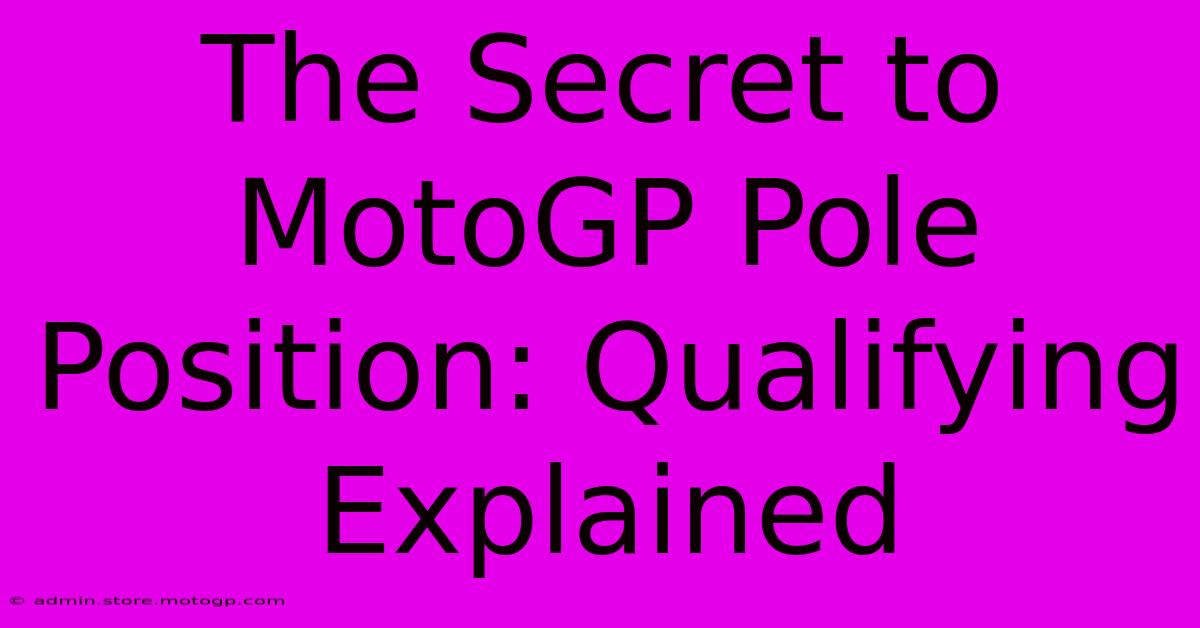The Secret To MotoGP Pole Position: Qualifying Explained

Table of Contents
The Secret to MotoGP Pole Position: Qualifying Explained
MotoGP, the pinnacle of motorcycle racing, is a spectacle of speed, skill, and strategy. But before the lights go out and the roar of the engines fills the air, there's a crucial battle fought: qualifying. Securing pole position, that coveted first place on the grid, is often the key to victory. This article delves into the secrets behind MotoGP qualifying, exploring the nuances of the format and the factors that contribute to a rider's success.
Understanding the MotoGP Qualifying Format
The qualifying process in MotoGP is a multi-stage affair, designed to separate the wheat from the chaff and determine the starting grid for the race. The current format typically involves:
Q1 (Qualifying 1):
- Participants: The ten slowest riders from the combined Free Practice (FP) sessions 1-3.
- Duration: 15 minutes of intense action.
- Objective: The top two riders from Q1 automatically progress to Q2. The remaining eight riders start the race from positions 13-20 based on their Q1 lap times.
Q2 (Qualifying 2):
- Participants: The ten fastest riders from the combined Free Practice sessions, plus the two riders who progressed from Q1.
- Duration: 15 minutes of high-stakes competition.
- Objective: The positions from 1st to 12th on the grid are decided here, with the fastest rider claiming pole position.
Key Factors Determining Pole Position
While raw speed is paramount, numerous other factors contribute to a rider's qualifying performance:
1. Bike Setup:
The perfect balance between handling, stability, and outright speed is crucial. Teams spend countless hours fine-tuning the bike's setup, experimenting with different tire compounds, suspension settings, and aerodynamic configurations to optimize performance for the specific track conditions. A poorly setup bike can ruin even the most talented rider's chances.
2. Tire Choice:
Choosing the right tire is critical. The grip levels offered by different tire compounds vary significantly, with softer compounds providing more grip but degrading faster. Riders and their teams must carefully consider the track temperature, weather conditions, and the number of laps needed to achieve a fast lap time when selecting their tires. A wrong tire choice can be disastrous.
3. Track Conditions:
MotoGP tracks are diverse and unpredictable. Changes in weather, track temperature, and even the presence of rubber laid down by previous sessions can drastically alter the ideal riding line and tire performance. Riders need to adapt their riding style to these changing conditions, and the teams need to have contingency plans for unexpected events. Adaptability is key.
4. Rider Skill and Experience:
Ultimately, qualifying success hinges on the rider's skills. A rider's ability to push the limits of their machine, maintain consistent lap times under immense pressure, and execute perfect lines and maneuvers is crucial. Experience in reading track conditions and making crucial split-second decisions is invaluable.
5. Team Strategy and Support:
The rider's success isn't solely reliant on their abilities; it also depends heavily on the support and strategy provided by their team. This includes providing accurate data, quick bike changes, and crucial strategic advice during the qualifying sessions. A strong team can provide a significant edge.
6. Slipstream (Drafting):
In MotoGP qualifying, drafting plays a crucial role. Riders often follow closely behind each other to reduce air resistance, gaining a significant speed advantage before making their overtake to set a quick lap. Mastering the art of slipstreaming is an important skill for MotoGP riders.
The Importance of Pole Position
Starting from pole position offers several key advantages:
- Better Race Start: A front-row start allows riders to avoid the chaos of the opening laps, crucial in avoiding early crashes.
- Track Position: Being at the front allows riders to control the race pace and dictate the strategy.
- Psychological Advantage: Securing pole position boosts the rider's confidence and can exert psychological pressure on rivals.
Conclusion
Securing pole position in MotoGP is a complex interplay of technical expertise, strategic decisions, and pure rider skill. Understanding the nuances of the qualifying format, managing track conditions, and making the right choices concerning bike setup and tires can be the difference between starting from the front and battling from the back. The race to the chequered flag begins long before the lights go out, and the qualifying session is the first crucial step towards victory.

Thank you for visiting our website wich cover about The Secret To MotoGP Pole Position: Qualifying Explained. We hope the information provided has been useful to you. Feel free to contact us if you have any questions or need further assistance. See you next time and dont miss to bookmark.
Featured Posts
-
Cota Concert Schedule Find Your Next Concert Adventure
Feb 19, 2025
-
Columbus Sightseeing Simplified With Cota One Day Pass
Feb 19, 2025
-
The Aero Future Whats Next For Moto Gp
Feb 19, 2025
-
The Moto Gp Goat A Legend In The Making
Feb 19, 2025
-
Moto Gp Qualifying The Path To Pole Position
Feb 19, 2025
